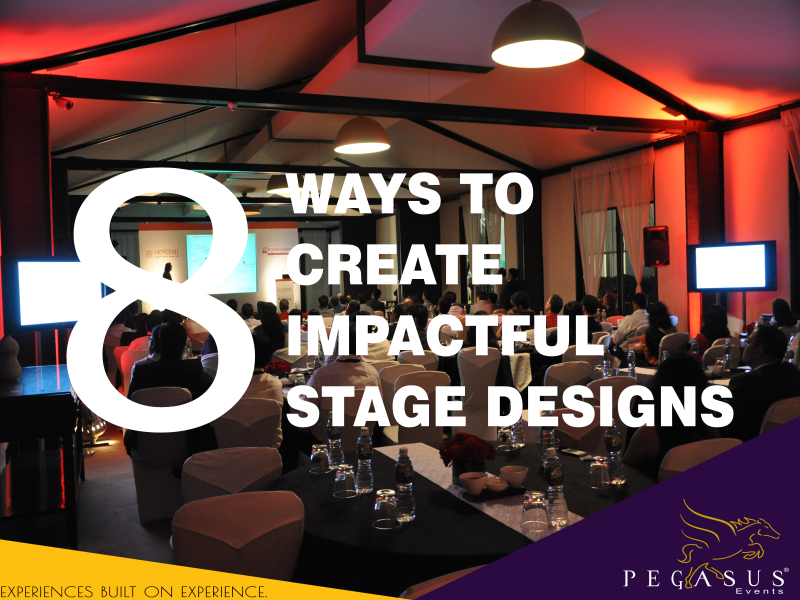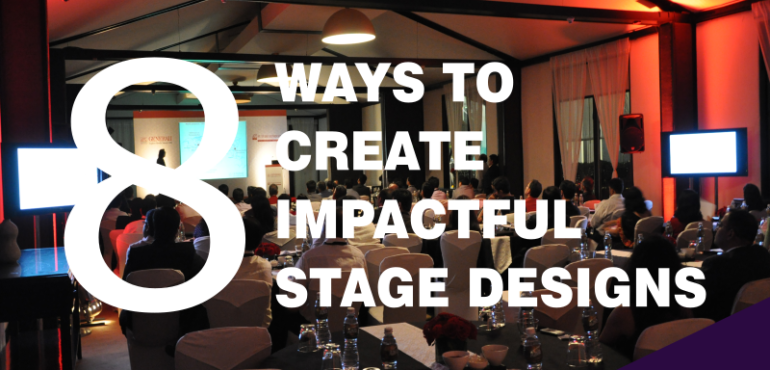Ultimate guide to approving the most impactful stage design for your next company event!

A blog about impactful corporate event stage designs by Pegasus Events
Event Stage Design for speakers and presenters may seem like a simple matter compared to creating an elaborate performance platform.
But the success of a presentation—and of the people delivering their messages—depends on minute details like size, lighting, and accessibility, as well as the right selection of microphones and lecterns.
We list down 8 ways you can make sure you get your event stage design right and create a maximum impact on driving home the objective out of doing the event.
Choose the correct height.
Consider guests line of sight and comfort when choosing the right elevation for your stage.
For any presentation, 1.5 ft off the ground is considered ideal for seated audiences of up to 200.What you need to consider while doing so, however, is the total clear height you have available at the venue.
The height for the event stage design would need to increase depending on the size of the audience and can go up to 5 feet.
Use appropriate lighting.

Lighting should be properly situated for all of the individuals who will be standing on the stage at various heights.
Though it may seem surprising, stage lighting is often the most forgotten element and is also the most important not only during the event but also for the photos and videography done.
What we recommend is to black out the entire room and control the lighting from the console to have effective brightness as required. Never use only one profile light for the speaker, there are many speakers who like to move around and a minimum of 2 lights are required besides the general house lighting.
Make sure audio is loud and clear.
In addition to lighting, quality sound also contributes to the effective communication of target messages and to an overall positive audience experience.
The most important thing is ensuring there is no feedback and there is an effective sound distribution across the venue. If you were to imagine your conference venue to be a square, it is essential to place at least one speaker in each corner of the venue.
Depending on the size of the audience, ensure all areas are covered by placing speakers at regular intervals. For a 200 capacity event, 4 speakers are required and you can increase the number of speakers by 2 for every 200 pax extra.
While a PA system is sufficient for a formal conference, you must have mid’s and bass speakers for any entertainment you might have. The effect of bass can be limited and your event agency can create effective combinations basis the type of entertainment you have at the event.
Select microphones based on speakers.
Always check with your speakers as to how they prefer to present. You will find presenters who like being stationary at the lectern while you will also find presenters who like to move around on stage. Many presenters use hand movements for effective communication as well.
The best thing to do is prepare for all contingencies. Have lectern mics, lapel mics as well as cordless mics for audiences to ask questions clearly. Ensure that post every presentation your event crew is standing by waiting to pass the mics to whoever requires it.
Always Brand the Lectern.
A lectern may seem like the most basic and ordinary of staging needs for presentations, but branding the lectern is important as all hotels and venues have different lecterns and unfortunately, the lectern can be an eyesore in the middle of the stage if it is not branded.
The branding should not have too much information, just the company logo with the central color theme for the overall stage should work.
Keep it simple.
“Simplicity is the ultimate sophistication!” – Leonardo Da Vinci
Elaborate stage decor or sets may pose a distraction for speakers, as well as audience members—those watching live or those watching virtually or at a later time.
We recommend a clean and crisp end to end set-up which is elegant in itself and adds the grandeur required.
Allow easy access.
A stage with insufficient or complicated access can pose a threat to a successful event.
It is always advisable to have multi-layered panelling for ease of access, the speakers may as well enter from the front or the sides, but in the case of entertainment and any props which need to be rolled out onto the stage, they need to enter from behind the stage.
Remember: Size matters.
You always should have your agenda and speakers decided well before you plan for the stage and design.
Absolutely everything at your event needs to work like clockwork, in complete balance and needs to compliment each other, only then can you create an extremely impactful event.
Having offered this service to more than 50+ fortune 500 companies and over 1100 events later, we are fairly certain to have got it right but we ofcourse never stop learning 🙂
Would love to hear your thoughts.



there are things which you can use for design your stage and these above mentions ways provide great help to promote your event. through these best ways you can not only organised good event but also attract your audience toward your event.
Thanks for sharing nice post
Thanks for sharing nice post